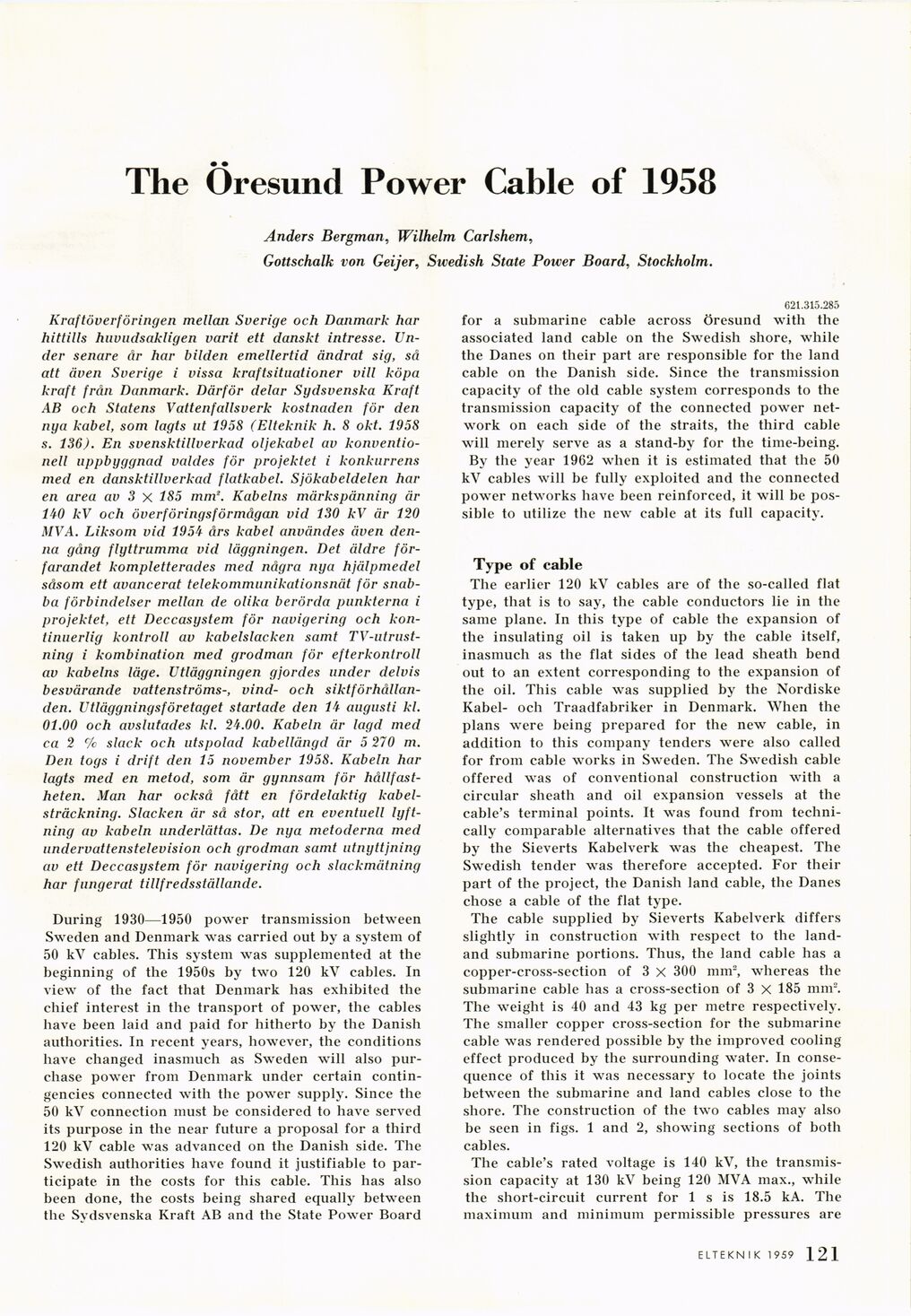
Full resolution (JPEG) - On this page / på denna sida - The Öresund Power Cable of 1958, by Anders Bergman, Wilhelm Carlshem and Gottschalk von Geijer

<< prev. page << föreg. sida << >> nästa sida >> next page >>
Below is the raw OCR text
from the above scanned image.
Do you see an error? Proofread the page now!
Här nedan syns maskintolkade texten från faksimilbilden ovan.
Ser du något fel? Korrekturläs sidan nu!
This page has never been proofread. / Denna sida har aldrig korrekturlästs.
The Öresund Power Cable of 1958
Anders Bergman, Wilhelm Carlshem,
Gottschalk von Geijer, Swedish State Power Board, Stockholm.
Kraftöverföringen mellan Sverige och Danmark har
hittills huvudsakligen varit ett danskt intresse.
Under senare år har bilden emellertid ändrat sig, så
att även Sverige i vissa kraftsituationer vill köpa
kraft från Danmark. Därför delar Sydsvenska Kraft
AB och Statens Vattenfallsverk kostnaden för den
nya kabel, som layts ut 1958 (Elteknik h. 8 okt. 1958
s. 136). En svensktillverkad oljekabel av
konventionell uppbyggnad valdes för projektet i konkurrens
med en dansktillverkad flatkabel. Sjökabeldelen har
en area av 3 x 185 mm2. Kabelns märkspänning är
140 kV och överföringsförmågan vid 130 kV är 120
MVA. Liksom vid 1954 års kabel användes även
denna gång flyttrumma vid läggningen. Det äldre
förfarandet kompletterades med några nya hjälpmedel
såsom ett avancerat telekommunikationsnät för
snabba förbindelser mellan de olika berörda punkterna i
projektet, ett Deccasystem för navigering och
kontinuerlig kontroll av kabelslacken samt
TV-utrust-ning i kombination med grodman för efterkontroll
av kabelns läge. Utläggningen gjordes under delvis
besvärande vattenströms-, vind- och
siktförhållan-den. Utläggningsföretaget startade den 14 augusti kl.
01.00 och avslutades kl. 24.00. Kabeln är lagd med
ca 2 % slack och utspolad kabellängd är 5 270 m.
Den togs i drift den 15 november 1958. Kabeln har
lagts med en metod, som är gynnsam för
hållfastheten. Man har också fått en fördelaktig
kabelsträckning. Slacken är så stor, att en eventuell
lyftning av kabeln underlättas. De nya metoderna med
undervattenstelevision och grodman samt utnyttjning
av ett Deccasystem för navigering och slackmätning
har fungerat tillfredsställande.
During 1930—1950 power transmission between
Sweden and Denmark was carried out by a system of
50 kV cables. This system was supplemented at the
beginning of the 1950s by two 120 kV cables. In
view of the fact that Denmark has exhibited the
chief interest in the transport of power, the cables
have been laid and paid for hitherto by the Danish
authorities. In recent years, however, the conditions
have changed inasmuch as Sweden will also
purchase power from Denmark under certain
contingencies connected with the power supply. Since the
50 kV connection must be considered to have served
its purpose in the near future a proposal for a third
120 kV cable was advanced on the Danish side. The
Swedish authorities have found it justifiable to
participate in the costs for this cable. This has also
been done, the costs being shared equally between
the Sydsvenska Kraft AB and the State Power Board
621.315.285
for a submarine cable across Öresund with the
associated land cable on the Swedish shore, while
the Danes on their part are responsible for the land
cable on the Danish side. Since the transmission
capacity of the old cable system corresponds to the
transmission capacity of the connected power
network on each side of the straits, the third cable
will merely serve as a stand-by for the time-being.
By the year 1962 when it is estimated that the 50
kV cables will be fully exploited and the connected
power networks have been reinforced, it will be
possible to utilize the new cable at its full capacity.
Type of cable
The earlier 120 kV cables are of the so-called flat
type, that is to say, the cable conductors lie in the
same plane. In this type of cable the expansion of
the insulating oil is taken up by the cable itself,
inasmuch as the flat sides of the lead sheath bend
out to an extent corresponding to the expansion of
the oil. This cable was supplied by the Nordiske
Kabel- och Traadfabriker in Denmark. When the
plans were being prepared for the new cable, in
addition to this company tenders were also called
for from cable works in Sweden. The Swedish cable
offered was of conventional construction with a
circular sheath and oil expansion vessels at the
cable’s terminal points. It was found from
technically comparable alternatives that the cable offered
by the Sieverts Kabelverk was the cheapest. The
Swedish tender was therefore accepted. For their
part of the project, the Danish land cable, the Danes
chose a cable of the flat type.
The cable supplied by Sieverts Kabelverk differs
slightly in construction with respect to the
land-and submarine portions. Thus, the land cable has a
copper-cross-section of 3 X 300 mm2, whereas the
submarine cable has a cross-section of 3 X 185 mm2.
The weight is 40 and 43 kg per metre respectively.
The smaller copper cross-section for the submarine
cable was rendered possible by the improved cooling
effect produced by the surrounding water. In
consequence of this it was necessary to locate the joints
between the submarine and land cables close to the
shore. The construction of the two cables may also
be seen in figs. 1 and 2, showing sections of both
cables.
The cable’s rated voltage is 140 kV, the
transmission capacity at 130 kV being 120 MVA max., while
the short-circuit current for 1 s is 18.5 kA. The
maximum and minimum permissible pressures are
ELTEKNIK 1959 1 121
<< prev. page << föreg. sida << >> nästa sida >> next page >>